Abstract
The issue of inclusive development of resource regions has received increasing attention. In this respect, understanding the social effects of extractive activities has tremendous importance. This paper aims to explore the impact of extractive activity on social well-being in resource- dependent regions of Russia. For this, the paper conducts a comparative analysis of the main social indicators in resource-dependent and non-resource regions of Russia. Then, the relationship between extractive activities and social indicators for resource-dependent regions is studied using the coefficients of pairwise correlation. The analysis revealed that there are statistically significant differences in indicators of social well-being between resource-dependent and non-resource regions. Resource-dependent regions have higher per capita income and lower poverty rates than non-resource regions, while indicators characterizing social inequality, crime, life expectancy, and incidence are worse. However, the study did not find a strong linear relationship between extractive activities and the social indicators. The results allow us to conclude that resource-dependent regions in Russia do not meet the principles of inclusive development.
Keywords: Social well-being, resource-dependent regions, inclusive development
Introduction
The role of natural resources in socio-economic development is controversial. Many researches have examined the existence and inevitability of the resource curse at national and regional levels. The resource curse theory states that natural resource abundance impedes long-term economic growth (Sachs & Warner, 2001). There are studies both supporting (Damettie & Serhir, 2018; Haggerty et al., 2014) and disproving (Arin & Braunfels, 2018; James, 2015; Ouoba, 2016) this theory. Researchers mainly focus on the relationship between natural resources and the growth rate of gross domestic product.
At the same time, the concept of inclusive development has been gaining popularity. According to this concept, natural resource use should meet the needs and interests of all citizens who should be involved in extractive activities by receiving benefits and participating in the decision-making process (Ariza et al., 2020). The main dimension of inclusive development is social well-being. Therefore, social effects of extractive activities and the distribution of benefits and costs from natural resource extraction deserve more attention.
Exploring the relationship between natural resource abundance and economic growth, many researchers focus on country-level and cross-country analyses (Arin & Braunfels, 2018; Damettie & Serhir, 2018; James, 2015; Ouoba, 2016). However, some works investigate social effects of extractive activities for producing regions, counties or municipalities and make cross-regional comparisons (Agerton et al, 2017; Ariza et al., 2020; Brown, 2014; Rawashdeh et al., 2016). This cross-regional analysis has certain advantages, as differences in history, culture, institutions and politics among regions are not as significant as differences among countries. Moreover, extractive activities most affect local population.
This paper contributes to the literature by performing a comparative analysis of social well-being in resource-dependent and non-resource regions of Russia and examining the relationship between extractive activities and the main social indicators.
Problem Statement
Inclusive development aims to enhance social well-being and reduce social inequality through an open and equitable distribution of wealth among the population (Pouw & Gupta, 2017). Thus, natural resource extraction should bring benefits to all citizens and improve social well-being in producing region. Extractive activities may have different social effects for producing region.
Many researchers analyse the impact of natural resource extraction on employment and income. For example, Marchand (2012) studied the impacts of the oil and gas sector on local labour markets in Western Canada during the period from 1971 to 2006, and found that total employment, total earnings and earnings per worker considerably increased in the boom period. Michaels (2011) also detected a positive correlation between oil production and local employment and per capita income for oil abundant counties in the Southern United States. These results are consistent with the findings of Brown (2014) on a positive impact of natural gas production on local employment and wages for the central United States. In contrast, Haggerty et al. (2014) argue that long-term oil and gas specialization has a negative effect on per capita income for the Western United States. They also discovered that a major share of the oil and gas sector in the local economy results in higher crime rates and lower level of education. Moreover, the negative socio-economic effects increase with the duration of oil and gas dependence.
The main goal of inclusive development is to reduce social inequality and poverty. The impact of natural resource extraction on poverty and social inequality is mixed. Some researchers believe that mineral resource extraction reduces poverty through different mechanisms (Aragón & Rud, 2013; Mabali & Mantobaye, 2017). Others, on the contrary, argue that mining sector can exacerbate poverty (Deaton & Niman, 2012; Loayza et al., 2013) and raise social inequality (Loayza et al., 2013).
A number of studies seek to assess several dimensions of social well-being. Hajkowicz et al. (2011) explore the influence of mineral production on such social indicators as household income, housing affordability, access to communication services, education, life expectancy and unemployment for regions in Australia. They found that mining has positive impact on income, housing affordability, communication access, education rate and employment. However, life expectancy has a negative correlation with mineral production. Rawashdeh et al. (2016) study the impacts of extractive activates on poverty, unemployment, education, Human Development Index, health and environment in the Southern Region of Jordan. The researchers suggest that resource development has no significant socio-economic effects for the regions. Ariza et al. (2020) investigate the relationship between mining-energy sector and inclusive development indicators such as education, health, security, and the quality of the local public management in Columbia. They detect that in general, mining-energy municipalities have better social indicators than in other municipalities. However, the results of their regression analysis are not ambiguous.
For Russia, Belousova (2015) compared the indicators of poverty, mortality, incidence, social inequality and crime in resource-dependent and non-resource regions in 2012 and concluded that resource-dependent regions had worse social performance. Studying the socio-economic development of resource-dependent regions of Russia for the period 2001-2014, Tokarev (2017) found that these regions have better provision of physician services and worse housing provision than the country in general.
Thus, the impacts of extractive activities on social well-being are mixed. There is evidence of both positive and negative social effects in the literature. Inclusive development policies seek to enhance social well-being. Therefore, the issue of estimating social effects and increasing social benefits from extractive activities needs more attention. This problem is particularly important for Russia, where almost one third of regions are resource-dependent.
Research Questions
The study seeks to answer the following research questions:
- How do extractive activities affect social well-being?
- Are there differences in social indicators among resource-dependent and non-resource regions of Russia?
- To what extent do resource-dependent regions meet the principles of inclusive development?
Purpose of the Study
The purpose of the study is to investigate the impact of extractive activities on social well-being and, thereby, on inclusive development in resource-dependent regions of Russia.
Research Methods
Based on the literature and available data, we chose a set of indicators to explore social well-being in Russian regions. The indicators allow us to assess such aspects of social well-being as income, housing provision, poverty, social inequality, health, and crime.
One of the main indicators of social well-being is income per capita. Since the level of consumer prices may differ significantly across regions of Russia, we used the ratio of income per capita to the overall cost of a fixed basket of consumer goods and services. We denoted these indicators as.
The indicator of housing provision was measured as comfortable housing space per person in square meters. This indicator was denoted as. The unemployment indicator (denoted as) is the share of total registered unemployed people in the total working-age population.
To assess social inequality, we applied the Gini coefficient (denoted as) and to measure poverty, we used the percentage of population with incomes below subsistence level (denoted as). As the health indicators, we chose the incidence rate (denoted as), and average life expectancy (denoted as). The value of these indicators is largely due to the environmental health and level of medical service in a region. The crime indicator was measured as the number of crimes per 100,000 people (denoted as)
The selected indicators comprehensively characterize social well-being of Russian regions.
As a proxy of extractive activities we used the added value per capita produced in extractive industry (denoted as). This indicator is often used in the literature (Alexeev & Chernyavskiy, 2015; Rawashdeh et al., 2016).
Our sample includes 84 regions of Russia. Due to the lack of necessary data, we excluded the Republic of Crimea and the city of Sevastopol from the sample. We also excluded the city of Moscow, which does not have any deposits, but receives great revenues from natural resource extraction since the headquarters of major Russian mining companies are located here.
We considered a region as resource-dependent if the share of extractive industry in the total region’s added value for a ten-year period is higher than the value of this indicator for the country in general. We classified 24 regions as resource-dependent. These regions are Nenets Autonomous Okrug, Yamalo-Nenets Autonomous Okrug, Khanty-Mansi Autonomous Okrug, Sakhalin Oblast, Chukotka Autonomous Okrug, Republic of Sakha (Yakutia), Magadan Oblast, Tyumen Oblast (without autonomous okrugs), Krasnoyarsk Krai, Murmansk Oblast, Republic of Tatarstan, Irkutsk Oblast, Astrakhan Oblast, Tomsk Oblast, Belgorod Oblast, Republic of Karelia, Perm Krai, Orenburg Oblast, Kemerovo Oblast (Kuzbass), Republic of Khakassia, Samara Oblast, Udmurt Republic, Amur Oblast, Komi Republic.
At this stage of the study, we estimated the social indicators in all regions of Russia and compared them between resource-dependent and non-resource regions for the period from 2010 to 2018. Then, we investigated the relationships between extractive activities and the social indicators in resource-dependent regions using the coefficients of pairwise correlation.
The data for the study were obtained from the website of the Federal State Statistics Service of the Russian Federation (Rosstat). We performed the statistical analysis using R version 4.0.4.
Findings
A comparative analysis of the key indicators of social well-being found that resource-dependent regions have higher per capita income (Figure 1), lower unemployment (Figure 2) and lower poverty rate (Figure 3) than non-resource regions. These results are consistent with many studies which conclude that extractive activities increase total employment and total income by creating new jobs and providing high wages and salary (Brown, 2014; Marchand, 2012; Michaels, 2011).
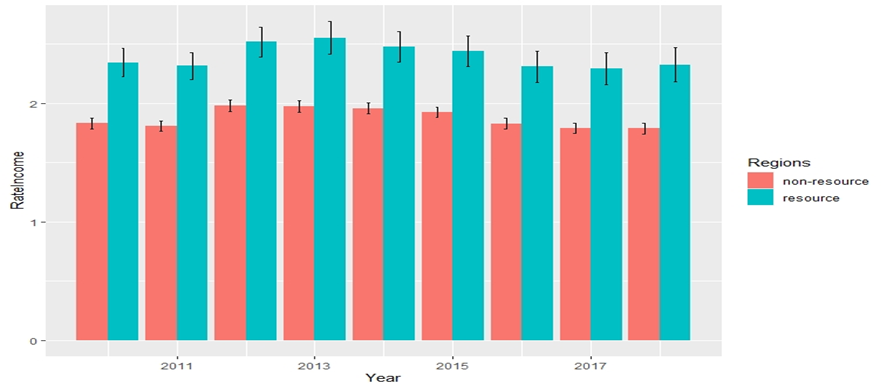
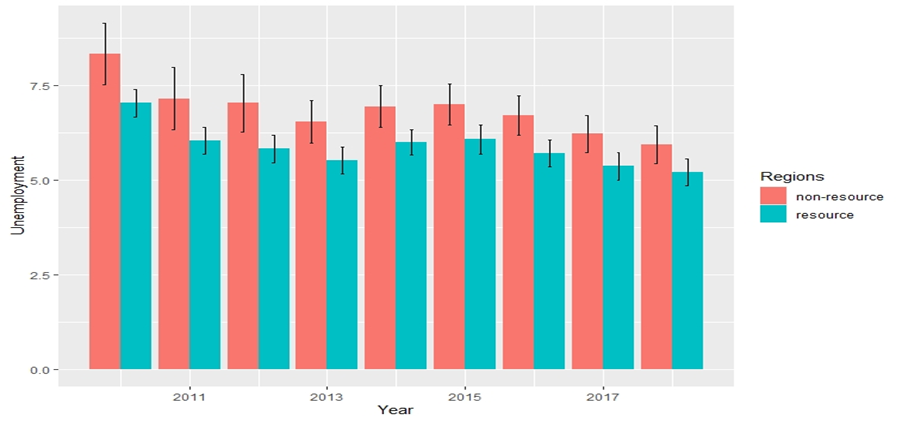
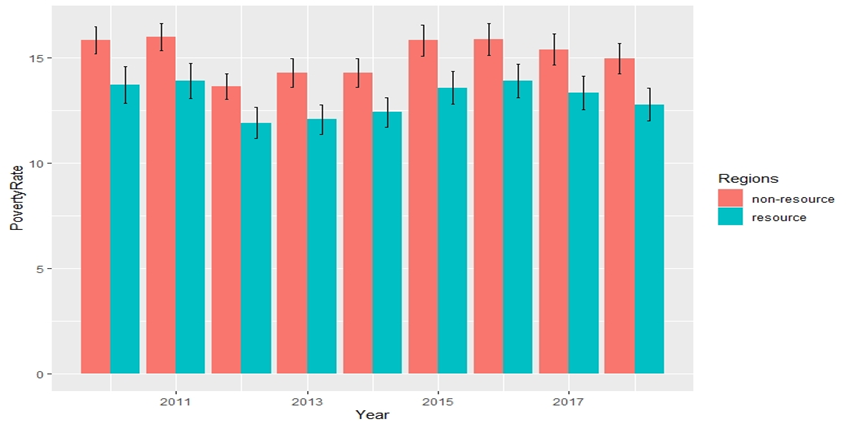
The housing provision has not been very different in recent years for resource-dependent and non-resource regions of Russia (Figure 4).
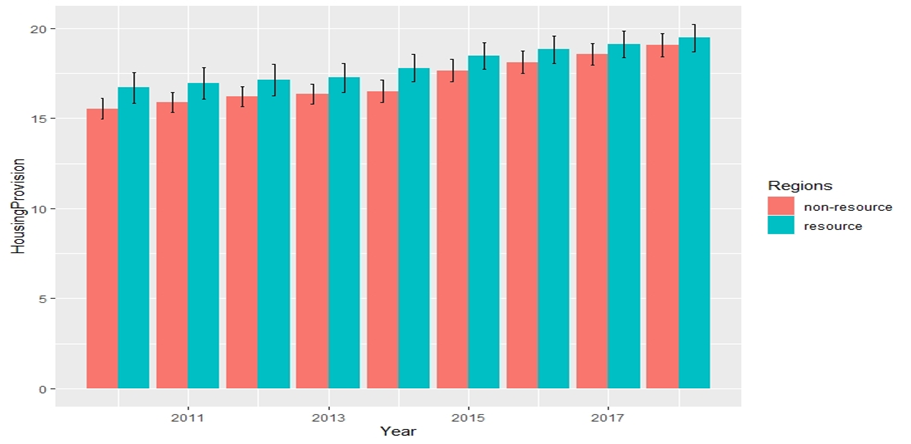
At the same time, resource-dependent regions are characterized by higher social inequality, as a higher Gini coefficient demonstrates (Figures 5). A possible explanation is that the salary in extractive sector is much higher than the average salary in a region.
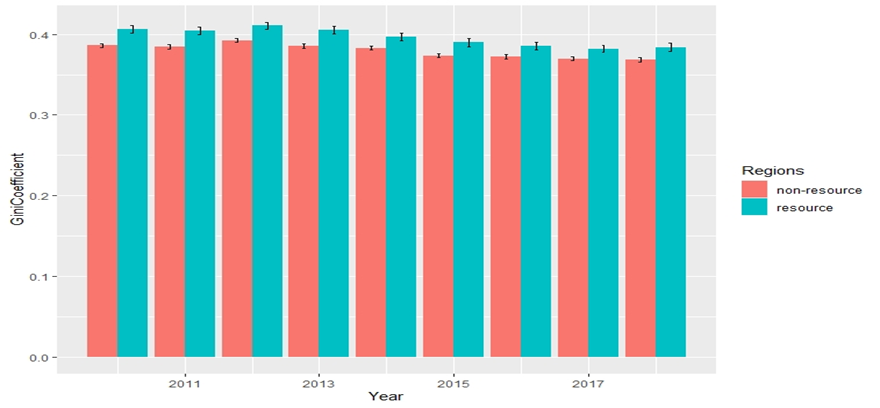
Life expectancy is slightly lower in resource-dependent regions than in their non-resource counterparts (Figure 6), but the incidence rate is significantly higher (Figure 7). We can assume that resource regions suffer more from environmental damage that negatively affects the human health.
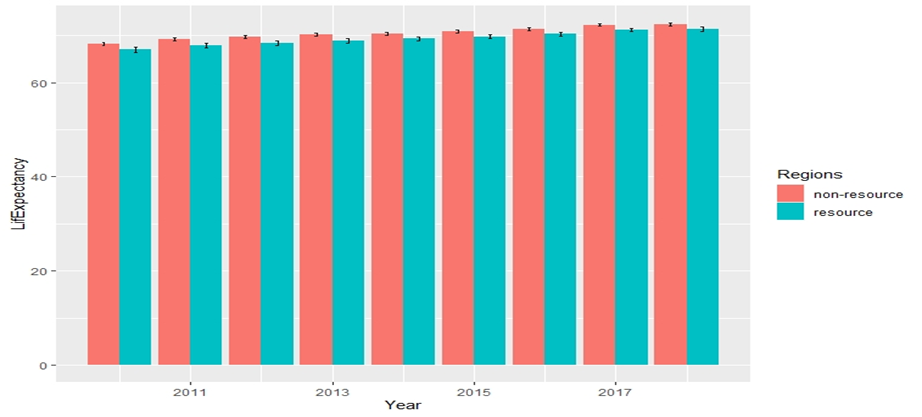
Figure 8 exhibits that the crime rate in resource-dependent regions is higher than that in non-resource regions. In the literature, there is evidence that extractive activities are associated with increasing crime (Haggerty et al., 2014; James & Smith, 2017).
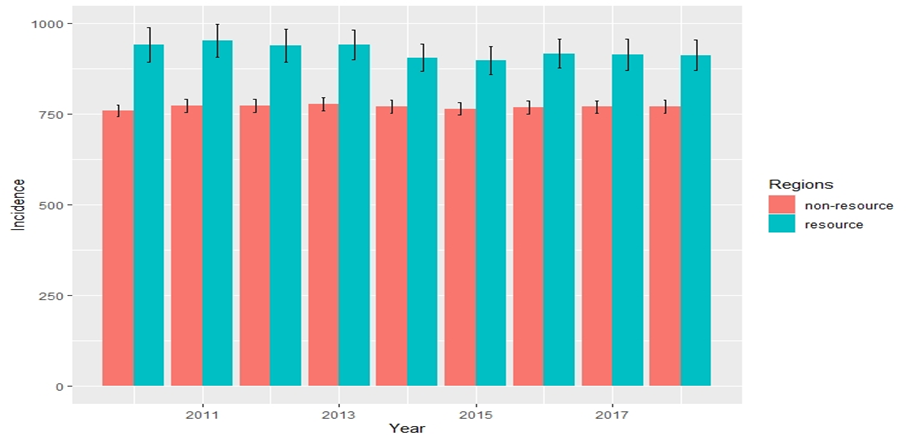
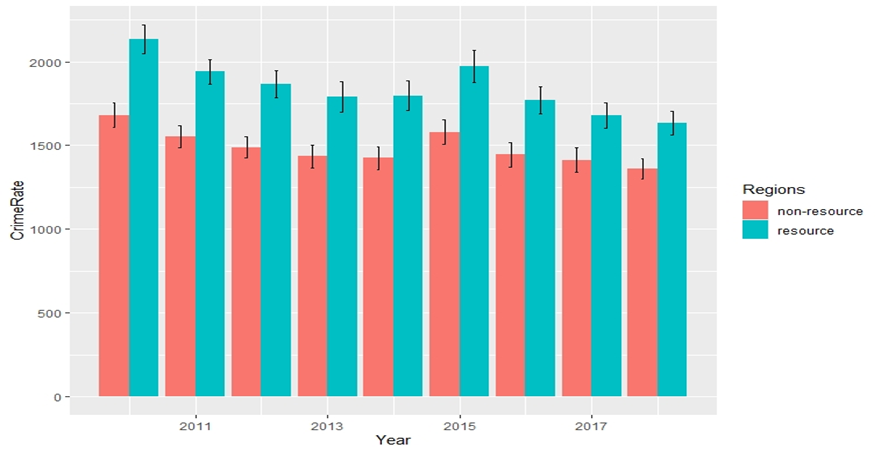
To confirm whether the indicators of social well-being in resource-dependent and non-resource regions really differ, we performed the t-test and Wilcoxon test. The null hypothesis is that the means of both samples are equal. The alternative is that two means are not equal.
Table 1 summarizes the test results, which suggest that the null hypothesis is rejected for most indicators exceptingandt in the Wilcoxon test at the 1% significant level.
Thus, most indicators of social well-being differ between resource-dependent and non-resource regions of Russia.
Some researchers believe that oil and gas activity has the greatest impact on socio-economic development (Haggerty et al., 2014). Therefore, we analysed the average values of the indicators for the study period across resource regions (Table 2).
We can see that the indicator values differ across resource-dependent regions. However, we did not find any relationship between the values of the indicators and the type of extracted resources.
To estimate the relationships between extractive activities and the indicators of social well-being in resource-dependent regions, we calculated the coefficients of pairwise correlation (Figure 9).
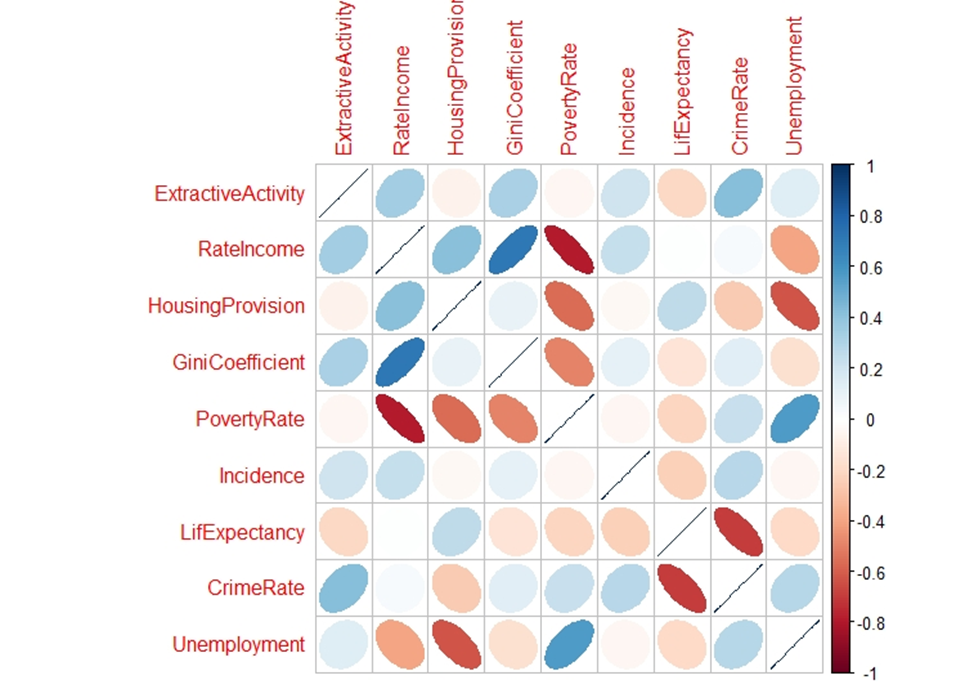
The results demonstrate that there is no strong linear relationship between extractive activities and the indicators of social well-being.
Conclusion
The inclusive development theory argues that all people in a region should receive benefits from natural resource extraction. Consequently, extractive activities should lead to improved regional social well-being. The comparative analysis revealed statistically significant differences in social indicators between resource-dependent and non-resource regions of Russia. Resource-dependent regions tend to have better indicators of per capita and poverty and worse indicators of social inequality, crime and incidence than non-resource regions. Thus, we can assume that extractive activities are associated with increasing income of population and reducing poverty. At the same time, natural resource extraction exacerbates social inequality, increases crime, and negatively affects human health. Thus, inclusive development is not typical for resource-dependent regions of Russia.
However, the impact of natural resource extraction on social well-being in Russian regions needs further research, since the relationship between extractive activities and social indicators remains unclear. A better understanding of the social effects of extractive activities is essential for adopting inclusive development policies in resource-dependent regions.
Acknowledgments
The research was carried out with the plan of research work of IEIE SB RAS, project 5.6.3.2. (0260-2021-0005) «Driving forces and mechanisms of development of cooperation and integration processes in the Siberian economy».
References
Agerton, M., Hartley, P. R., Medlock III, K. B., & Temzelides, T. (2017). Employment impacts of upstream oil and gas investment in the United States. Energy Economics, 62, 171-180. DOI:
Alexeev, M., & Chernyavskiy, A. (2015). Taxation of natural resources and economic growth in Russia’s regions. Economic Systems, 39, 317-338. DOI:
Aragón, F., & Rud, J. (2013). Natural Resources and Local Communities: Evidence from a Peruvian gold mine. American Economic Journal: Economic Policy, 5(2), 1-25. DOI:
Arin, K. P., & Braunfels, E. (2018). The resource curse revisited: A Bayesian model averaging approach. Energy Economics, 70, 170-178. DOI:
Ariza, J., Vargas-Prieto, A., & García-Est, ́ J. (2020). The effects of the mining-energy boom on inclusive development in Colombia. The Extractive Industries and Society, 7(4), 1597-1606. DOI:
Belousova, S. V. (2015). Resursnye regiony: ekonomicheskie vozmozhnosti i finansovaya spravedlivost [Resource regions: economic opportunities and financial justice], ECO, 6, 40-48. [in Rus.].
Brown, J. P. (2014). Production of natural gas from shale in local economies: a resource blessing or curse. Economic Review, (1).
Damettie, O., & Serhir, M. (2018). Natural resource curse in oil exporting countries: A nonlinear approach. International Economics, 156, 231-146. DOI:
Deaton, B., & Niman, E. (2012). An empirical examination of the relationship between mining employment and poverty in the Appalachian region. Applied Economics, 44(3), 303-312. DOI:
Haggerty, J., Gude, P. H., Delorey, M., & Rasker, R. (2014). Long-term effects of income specialization in oil and gas extraction: The U.S. West, 1980-2011. Energy Economics, 45, 186-195.
Hajkowicz, S. A., Heyenga, S., & Moffat, K. (2011). The relationship between mining and socio-economic wellbeing in Australia's regions. Resources Policy, 36, 30-38. DOI:
James, A. (2015). The resource curse: A statistical mirage? Journal of Development Economics, 114, 55-63.
James, A., & Smith, B. (2017). There will be blood: crime rates in shale-rich US counties. Journal of Environmental. Economics and Management, 84, 125-152. DOI:
Loayza, N., Mier y Teran, A., & Rigolini, J. (2013). Poverty, inequality, and the local natural resource curse. Discussion Paper, 7226. http://ftp.iza.org/dp7226.pdf
Mabali, A., & Mantobaye, M. (2017). Oil and Regional Development in Chad: Impact Assessment of DobaOil Project on the Poverty in Host Region. African Development Review, 29, 42-55. DOI:
Marchand, J. (2012). Local labor market impacts of energy boom-bust-boom in Western Canada. Journal of Urban Economics, 71, 165-174. DOI:
Michaels, G. (2011). The long term consequences of resource-based specialization. The Economic Journal, 3, 31-573. DOI:
Ouoba, Y. (2016). Natural resources: Funds and economic performance of resource-rich counties. Resources Policy, 50, 108-116. DOI:
Pouw, N., & Gupta, J. (2017). Inclusive development: a multi-disciplinary approach. Current Opinion in Environmental Sustainability, 24, 104-108 DOI:
Rawashdeh, R., Cambell, G., & Titi, A. (2016). The socio-economic impacts of mining on local communities: The case of Jordan. The Extractive Industries and Society, 3, 494-507. DOI:
Sachs, J. D., & Warner, A. M. (2001). Natural resources and economic development: the curse of natural resources. European Economic Review, 45, 827-838.
Tokarev, A. N. (2017). Osobennosti socialno-ekonomicheskogo razvitiya resursnyh regionov Rossii [Features of the Socio-Economic Development of Russian Resource Region]. Vestnik of North-Eastern Federal University, Economics, Sociology, Culturology, 1(05). [in Rus.].
Copyright information

This work is licensed under a Creative Commons Attribution-NonCommercial-NoDerivatives 4.0 International License.
About this article
Publication Date
25 September 2021
Article Doi
eBook ISBN
978-1-80296-115-7
Publisher
European Publisher
Volume
116
Print ISBN (optional)
-
Edition Number
1st Edition
Pages
1-2895
Subjects
Economics, social trends, sustainability, modern society, behavioural sciences, education
Cite this article as:
Nagaeva, O. S. (2021). Social Well-Being As A Key Component Of Inclusive Development In Resource-Dependent Regions. In I. V. Kovalev, A. A. Voroshilova, & A. S. Budagov (Eds.), Economic and Social Trends for Sustainability of Modern Society (ICEST-II 2021), vol 116. European Proceedings of Social and Behavioural Sciences (pp. 944-956). European Publisher. https://doi.org/10.15405/epsbs.2021.09.02.106

